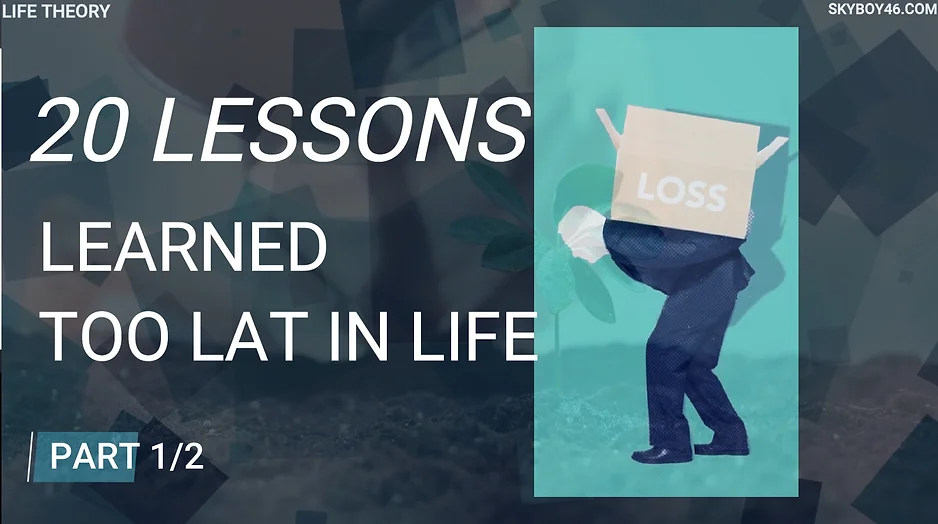Don’t Want To Read?
Watch/Listen To The Full Video on YouTube
What happens when our childhood fears evolve into adult anxieties, spiraling out of control into a never-ending cycle of dread? As we grow, we start to expect the worst, even in situations where nothing is wrong. This exploration delves into the psychology of catastrophizing—how it starts, why it happens, and how we can break free from it to embrace peace and live without the constant cloud of fear.
SUBSCRIBE: https://www.youtube.com/@LifeTheory46
Why Do We Always Expect the Worst – Life Stories 281
Why Do We Always Expect the Worst?
Think back to when you were a kid, climbing trees without a care, gripping a swing and soaring into the air as if you were flying, or maybe saying yes to a spontaneous night out with strangers during your college days. Risk felt like a thrill, a natural part of living. But somewhere along the line, that fearless spark fades. Now, even the thought of driving across town can bring a wave of worry. Your fears for your safety, your family, and everything you cherish creep in, sometimes overpowering your ability to just breathe and enjoy life. But where does this instinct to expect the worst actually come from, and can we break free from it?
When we’re young, our brains haven’t fully developed the ability to self-regulate. This isn’t some glitch in evolution; it’s intentional. Taking risks is a crucial part of growing up. It helps establish our understanding of what’s safe and where the boundaries are. But as the years pass, our brains change, and so do we. The rush from jumping off a ledge isn’t the same. In fact, we’d rather be nowhere near the edge at all.
Somewhere along the way, concern morphs into something darker—a fear that crosses a line and takes on a life of its own. This isn’t just anxiety; it’s catastrophizing. While anxiety has protective benefits, catastrophizing doesn’t. It’s more than just expecting the worst every now and then; it’s the constant feeling that disaster is inevitable, growing from a whisper of doubt into a scream that drowns out everything else.
It starts small—a fleeting thought, a nagging worry. But soon, that seed of doubt blossoms into a sprawling nightmare. Maybe your partner makes a casual comment about you not cleaning up, and suddenly, it’s spiraled in your mind: they’re unhappy, about to leave, and you’ll end up without a place to call home. All from one offhand remark that’s already been forgotten by the person who said it.
The worst part is, the catastrophes we imagine almost never happen. But our minds fool us into thinking we’re not strong enough to handle adversity, making the imagined pain seem unbearable. We overestimate how long it would take to recover if things did go wrong, leaving us trapped in a state of perpetual dread.
For many, this way of thinking traces back to childhood experiences, where the worst-case scenario wasn’t just a story—it actually happened. Whether it was a parent suddenly leaving, a family’s financial collapse, or the loss of someone close, these moments leave deep scars. Even if nothing catastrophic occurred, growing up with overprotective or highly critical parents can break down the trust you have in yourself to handle life’s challenges.
For those who catastrophize, even good things can feel like a ticking time bomb, a countdown to the moment when everything falls apart. It’s as if joy is just the calm before an inevitable storm. This mindset can even lead to self-fulfilling prophecies. The fear of tragedy becomes so intense that it feels almost easier to create the disaster ourselves, just to stop waiting for the other shoe to drop. It’s about feeling in control of the chaos, even if that control is just an illusion.
And let’s be honest, we’ve all fallen into catastrophizing at some point. Usually, we can shake it off with a bit of reassurance. But for some, the fear builds and builds, gaining momentum like a snowball tumbling down a mountain. It’s a struggle to explain the suffocating sense of dread and the constant cycle of worry that never seems to end.
Moving past this mindset isn’t easy, but it is possible. Therapy, especially cognitive behavioral techniques and rapid eye movement therapy, can help unravel these thought patterns. Mindfulness practices, too, are a powerful way to create some distance between the racing thoughts in your head and your emotional reactions. By observing these thoughts without judgment, you begin to understand where they come from and realize they don’t have to control you.
Take a moment now. Find a comfortable spot, let your gaze soften, and roll your shoulders back. Inhale deeply and close your eyes. Notice the world around you—listen for the faint sounds, feel the air against your skin. Now, bring your awareness inward. Watch your thoughts as they come and go, like cars passing by on a highway. They don’t need to be chased or clung to; they’re just passing by.
For a while, just be the observer of your mind, following the flow of your breath. There is power in recognizing that, even when your thoughts spiral, you can still find your way back to calmness. And with each breath, you’re taking a step towards releasing the grip of expecting the worst.
–> Read More Life Stories Here:
https://www.lifetheory.us
https://www.lifetheory.eu
Buy all of our Life Stories & Our Premium Learning Packs. Listen or Read to them anytime you want. Have them Forever.
You can get each monthly lesson on our website at https://www.skyboy46.com/store
SHARE THIS STORY
Visit Our Store
SHOP NOW
www.skyboy46.com & www.myskypet.com
Designed For Pet Lovers & Introverted Souls
Sport, Hobbies, Motivation, Music & Art






~EXPLORE MORE~
www.linktr.ee/skyboy46



